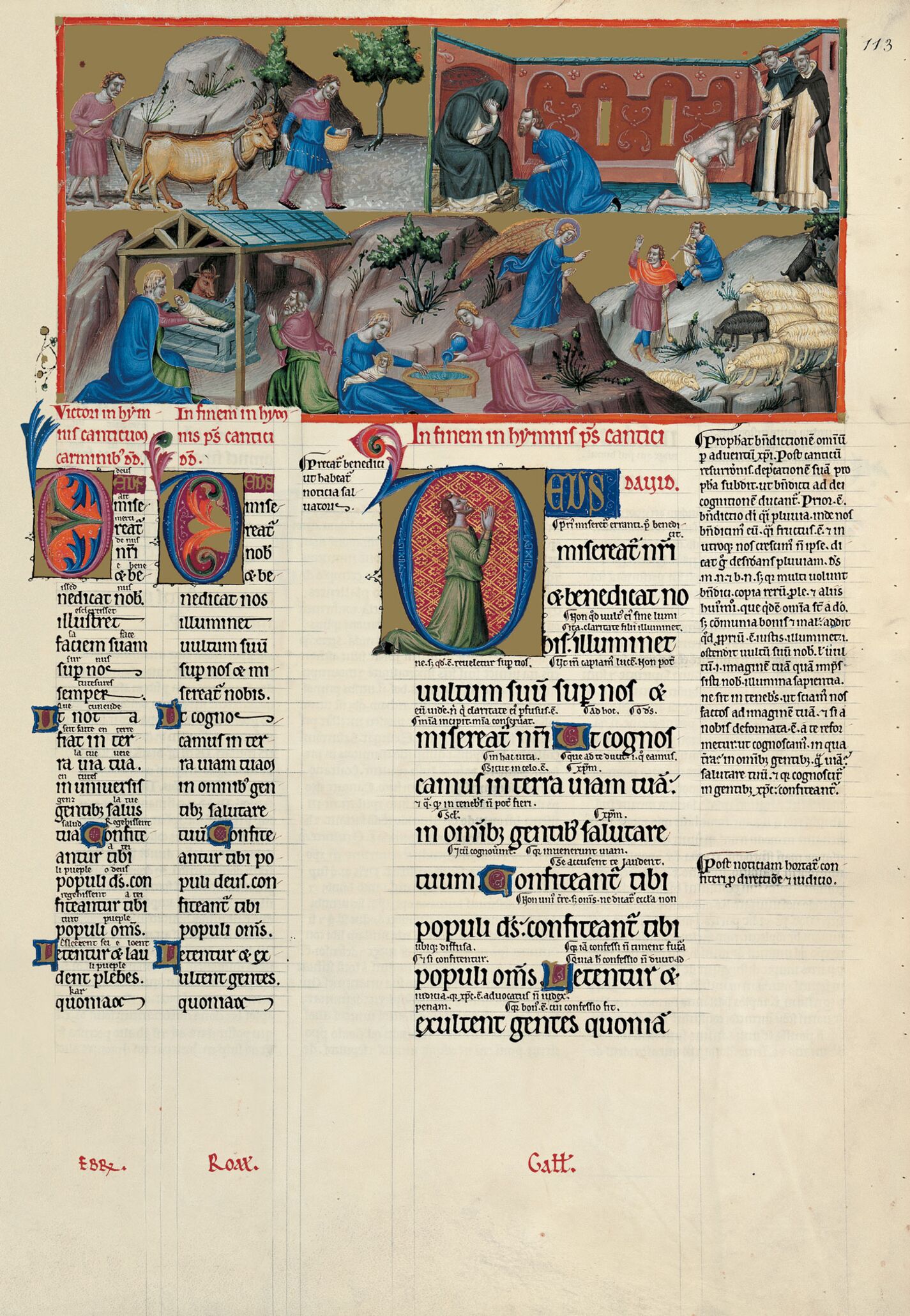Psalm 66 opens with a sowing scene in reference to the fruit the earth gave humanity who must praise God in recognition of his fairness (v. 7, Terra dedit fructum suum// The earth hath yielded her fruit). A man scatters seed as he walks along in front of two oxen pulling a plough led by another man. According to St Jerome, the fruit of the earth is Christ the saviour, born of the Virgin and of Adam’s stock (“Terra dedit fructum suum, Maria genuit Salvatorem”). The lower area features the Nativity of Jesus, the main episode in the childhood cycle often lengthened in the Byzantine and Italian world by the addition of other episodes combined in a single image. The programmer’s intention with this explicit reference to the fruit of Mary’s womb, born of the earth in the form of its human representative, is therefore perfectly clear.
The Virgin, as in the case of the Hours of Maria of Navarre, shows the carefully swaddled Child upon a cradle-tomb to St Joseph who adores him. A wooden structure with an Italian-style roof increases the space of the cave, towards the back of which the heads of the ox and the ass can be seen, their bodies hidden behind the marble case. Slightly further to the right, two young midwives prepare to bathe Jesus, paying attention, as in other cases, to the water temperature. This theme, so dear to the Italo-Byzantine tradition and already familiar to both Carolingian and twelfth-century English masters (Sigena), appears again in the Hours of Maria of Navarre (f. 61v). The rocky background behind both episodes extends to encompass an annunciation to the shepherds, which is not out of place in this context, since it confirms the coming of Christ to humanity. It must not be forgotten that the canticles of the psalm extol the Messiah as the fruit of the earth. In this way, the Virgin Mary presents him to the first faithful symbolised by St Joseph at prayer. They will witness the glory of God of Israel and his strength (v. 8, Benedicat nos Deus: et metuant eum omnes fines terrae // May God bless us: and all the ends of the earth fear him).
Back in the first register, we enter an attractive room where a confession is taking place. An old, prostrated man stretches his head out to expound his sins to a seated Dominican who covers his face to give the ensuing penance, whilst two clergies from the same order whip a half-naked penitent in the far corner of the room. The importance of the priest and the role of the Church in this series are conveyed by several unusual images alluding to the sacrament that guarantees the pardon of sins. It is not surprising that the theme appears again on f. 102v of the London Drecretum Gratiani (British Library, Add. Ms. 15275), a legal text of a clearly ecclesiastical nature which, in this splendidly illustrated version, is linked to the Bassas’ workshop.

Psalm 66 opens with a sowing scene in reference to the fruit the earth gave humanity who must praise God in recognition of his fairness (v. 7, Terra dedit fructum suum// The earth hath yielded her fruit). A man scatters seed as he walks along in front of two oxen pulling a plough led by another man. According to St Jerome, the fruit of the earth is Christ the saviour, born of the Virgin and of Adam’s stock (“Terra dedit fructum suum, Maria genuit Salvatorem”). The lower area features the Nativity of Jesus, the main episode in the childhood cycle often lengthened in the Byzantine and Italian world by the addition of other episodes combined in a single image. The programmer’s intention with this explicit reference to the fruit of Mary’s womb, born of the earth in the form of its human representative, is therefore perfectly clear.
The Virgin, as in the case of the Hours of Maria of Navarre, shows the carefully swaddled Child upon a cradle-tomb to St Joseph who adores him. A wooden structure with an Italian-style roof increases the space of the cave, towards the back of which the heads of the ox and the ass can be seen, their bodies hidden behind the marble case. Slightly further to the right, two young midwives prepare to bathe Jesus, paying attention, as in other cases, to the water temperature. This theme, so dear to the Italo-Byzantine tradition and already familiar to both Carolingian and twelfth-century English masters (Sigena), appears again in the Hours of Maria of Navarre (f. 61v). The rocky background behind both episodes extends to encompass an annunciation to the shepherds, which is not out of place in this context, since it confirms the coming of Christ to humanity. It must not be forgotten that the canticles of the psalm extol the Messiah as the fruit of the earth. In this way, the Virgin Mary presents him to the first faithful symbolised by St Joseph at prayer. They will witness the glory of God of Israel and his strength (v. 8, Benedicat nos Deus: et metuant eum omnes fines terrae // May God bless us: and all the ends of the earth fear him).
Back in the first register, we enter an attractive room where a confession is taking place. An old, prostrated man stretches his head out to expound his sins to a seated Dominican who covers his face to give the ensuing penance, whilst two clergies from the same order whip a half-naked penitent in the far corner of the room. The importance of the priest and the role of the Church in this series are conveyed by several unusual images alluding to the sacrament that guarantees the pardon of sins. It is not surprising that the theme appears again on f. 102v of the London Drecretum Gratiani (British Library, Add. Ms. 15275), a legal text of a clearly ecclesiastical nature which, in this splendidly illustrated version, is linked to the Bassas’ workshop.